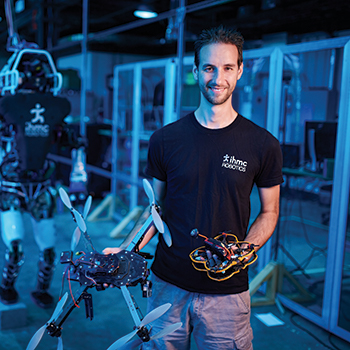
09
John Carff
Research Associate, Florida Institute for Human & Machine Cognition
Much of current robotics research focuses on disaster and military applications, but robots can also be used remotely, such as for nature surveillance or anywhere it is too dangerous for humans to go.
Tell us about the IHMC’s humanoid robot and the 2015 robotics challenge.
The Darpa Robotics Challenge was a worldwide robotics competition that began in December 2013 and ended with the finals in June 2015. The goal of this program was to advance human-supervised robotic technologies for disaster-response operations. For this challenge IHMC used an Atlas robot developed by Boston Dynamics, but all controls and software were developed in-house. We placed in the top two in all three of the challenges over the year, beating out teams from all over the world, including more commonly known teams like MIT, NASA, Lockheed Martin, CMU and many others. Our success is accredited to our advanced humanoid control techniques as well as an advanced user interface that I developed as my master’s thesis at UWF.
How long have you worked on Atlas?
I have been working at IHMC for the past 14 years, and for the last four years, my primary focus has been on Atlas development. I have taken the user interface I developed for my master’s thesis and turned it into a very powerful robot operator interface. My user interface has not only been used to operate our Atlas robot but also NASA’s Valkyry robot, various drones and other ground vehicles. Unlike other robotics interfaces, my software affords the robot more autonomy by using a coactive framework that uses supervised autonomy to allow the robot and operator to work as a team through a single intuitive user interface.
The human-robot team navigation system was very novel at the time you were working on it as a graduate student. How did the UWF program encourage this type of innovation?
I credit Dr. Eman El-Sheikh, the director of the Center for Cybersecurity for always pushing and encouraging me. She suggested that I publish and present my research, and as a graduate student, I was able to do that at the IEEE International Conference on Intelligent Robots and Systems. The same system is still used today to control a number of different robots at IHMC and NASA.


